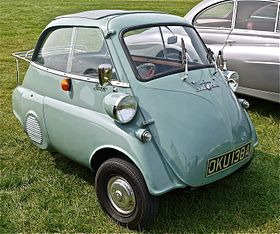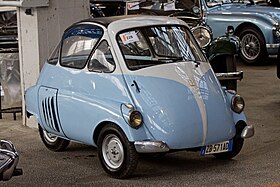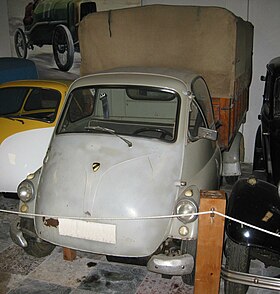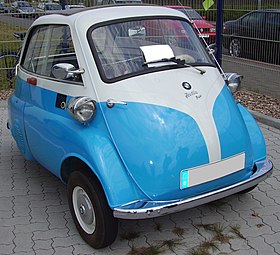Isetta
| Isetta | |
|---|---|
 |
|
| Overview | |
| Manufacturer | Iso Autoveicoli BMW VELAM Romi |
| Production | Iso Isetta (1953–56) BMW Isetta (1955–62) VELAM Isetta (1955–58) Romi-Isetta (1956–61) |
| Layout | MR layout |
| 1953 Iso Isetta | |
|---|---|
 |
|
| Overview | |
| Manufacturer | Iso Autoveicoli |
| Production | Iso Isetta (1953–56) |
| Designer | Ermenegildo Preti |
| Body and chassis | |
| Body style | Coupe |
| Layout | MR layout |
| Iso Autocarro | |
|---|---|

A 1958 Spanish built Iso Autocarro pick-up truck
|
|
| Overview | |
| Manufacturer | Iso |
| Also called | Isetta Autocarro |
| Production | 1954–58 |
| Assembly | Italy, Spain |
| Body and chassis | |
| Class | 1/2-ton truck |
| Body style | Pick-up Van |
| Layout | FMR |
| Platform | tubular steel ladder chassis |
| Related | Iso Isetta |
| Powertrain | |
| Engine | 236 cc split-single two-stroke engine |
| Transmission | 4-speed manual with reverse |
| Dimensions | |
| Wheelbase | 2,150 mm (85 in) |
| Length | 3,800 mm (148 in) |
| Width | 1,400 mm (55 in) (pickup box) |
| Curb weight | 475 kg (1,047 lb) empty 500 kg (1,100 lb) load capacity |
| BMW 300 (Isetta) | |
|---|---|
 |
|
| Overview | |
| Manufacturer | BMW |
| Also called | BMW Isetta |
| Production | 1956–62 161,360 produced |
| Layout | RR layout |
| Powertrain | |
| Engine | 298 cc single-cylinder 4-stroke (53 mph (85 km/h) top speed) |
| Transmission | 4-speed manual (with reverse) |
| Chronology | |
| Predecessor | BMW 250 |
| Successor | BMW 600 |
The Isetta is an Italian-designed microcar built under license in a number of different countries, including Spain,Belgium,France,Brazil,Germany, and the United Kingdom. Because of its egg shape and bubble-like windows, it became known as a bubble car, a name later given to other similar vehicles.
In 1955, the BMW Isetta became the world's first mass-production car to achieve a fuel consumption of 3 L/100 km (94 mpg‑imp; 78 mpg‑US). It was the top-selling single-cylinder car in the world, with 161,728 units sold.
Initially manufactured by the Italian firm Iso SpA, the name Isetta is the Italian diminutive form of ISO, meaning little ISO.
The car originated with the Italian firm of Iso SpA. In the early 1950s the company was building refrigerators, motor scooters and small three-wheeled trucks. Iso's owner, Renzo Rivolta, decided he would like to build a small car for mass distribution. By 1952 the engineers Ermenegildo Preti and Pierluigi Raggi had designed a small car that used the motorcycle engine of the Iso Moto 200 and named it Isetta—an Italian diminutive meaning little ISO.
The Isetta caused a sensation when it was introduced to the motoring press in Turin in November 1953, it was unlike anything seen before. Small (only 2.29 m (7.5 ft) long by 1.37 m (4.5 ft) wide) and egg-shaped, with bubble-type windows, the entire front end of the car hinged outwards to allow entry. In the event of a crash, the driver and passenger were to exit through the canvas sunroof. The steering wheel and instrument panel swung out with the single door, as this made access to the single bench seat simpler. The seat provided reasonable comfort for two occupants, and perhaps a small child. Behind the seat was a large parcel shelf with a spare wheel located below. A heater was optional, and ventilation was provided by opening the fabric sunroof.
...
Wikipedia
